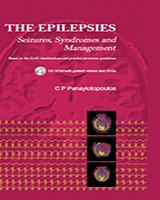From: Chapter 10, Idiopathic Generalised Epilepsies

NCBI Bookshelf. A service of the National Library of Medicine, National Institutes of Health.

Top: Video EEG recording of an 18-year-old woman with perioral myoclonia with absences (case 6 in ref 328). She was referred because of ‘focal motor seizures and secondarily GTCS’. She had onset of GTCS and absences at 11 years of age, which continued despite treatment with various combinations of valproate, ethosuximide, clonazepam, lamotrigine and acetazolamide. Absences were frequent, often in daily clusters and consisted of brief (about 5 s) moderate impairment of consciousness with violent rhythmic jerking of the jaw. GTCS occurred 1–10 times a year, usually after awakening, preceded by clusters of absences with the jaw myoclonus spreading to limb jerks prior to generalised convulsions. She was more concerned about the absences because they interfered with her daily life “everyone notices the jerks of my jaw” and less about the GTCS, which usually occurred at home. The initial misdiagnosis of ‘focal motor seizures’ was because the jaw jerking was perceived and described by her mother as unilateral.
Bottom: EEG of 23-year-old woman while in perioral status epilepticus (case 2 in ref 328). She was mildly confused with continuous perioral twitching. This ended with a GTCS. Initial presentation at 11 years of age was with GTCS. PMA was noted at the same time and was diagnosed as focal motor seizures. Despite medication with valproate, she continues having infrequent episodes of ASE terminated with self-administered benzodiazepines.
From: Chapter 10, Idiopathic Generalised Epilepsies

NCBI Bookshelf. A service of the National Library of Medicine, National Institutes of Health.